PSEB 12th Class Physical Education Practical Cricket
Cricket Game History
Cricket is one of the most interesting popular sport of world played both men and women by using a ball and a wooden bat. Cricket was originated in south-eastern part of England. Some people think that it is originated in France, while others think that it originated in England. The Hembildon Club of cricket was formed in England in year 1760. Second cricket club came into existance in 1787 or Melbourne Cricket Club (M.C.C.).
The first test match was played in 1877 between Australia and England at Melbourne which was won by Australia. MCC deck gave proper shape to cricket by framing rules of this game in 1835. During the First half of the 20th century, cricket spread to other Commonwealth countries. International Cricket Council (I.C.C) look after the affairs of cricket and organise the ICC trophy after every four years. The first world cup was held in 1975. British were credited to introduce Cricket in India.
The first official match was played in 1933 at Gymkhana ground in Mumbai. Under the Captainship of Mr. Kapil Dev India had won World Cup in 1983. First one day match was played on 5 January 1971 and became India’s popular game in India. Board of Cricket Control manages the affairs of cricket. A new form of a fast cricket is coming up which is popular as Twenty-Twenty in which both the teams have to play for only 20 overs each.
![]()
Cricket Game Important Points
- Number of players in a team:16(11-5)
- Distance from wicket to wicket:22 yards 20.12 Metre
- Breadth of the Pitch:10’ (3.05 metre)
- Breadth of wicket:9” (22.9 cm)
- Circumference of the ball:8.81-9 inches
- Circumference of wickets:3.49 – 3.81 cm
- Weight of the ball:155.9 gm – 163 gm
- Breadth of the bat:4.25 (10.8 cm)
- Length of the bat:38” (96.52 cm)
- Colour of the ball:Red for day match, white for night match
- The diameter of outer circle from centre:137 m – 150 m
- The height of wicket from floor:28″(71 cm)
- Type of Match:20-20,one day,test machs.
- Number of umpires:Two,one third umpire.
- The area of small circle:27.4
- Length of bowling crease (from centre of stumps):8’8″(2.64 m)
Cricket Game Rules And Regulations
- The match is played between two teams. Each team has eleven players (Twelfth man in case of injury only).
- Two umpires are appointed for the match one for each end (One third umpire).
- The scorer keeps record of all the runs scored.
- A player can be substituted in case of injury or illness. A substitute is not allowed to bat or bowl. He can run for the other player between the wickets or can do fielding.
- A substitute cannot do fielding at his special position.
- The captains of the team decide which team is to bat and which is to do fielding.
- A new ball is taken at the start of each innings. A new ball can also be taken after 200 runs have been scored or after 75 overs. A new ball can also be taken in case the ball is lost or damaged but its condition should resemble that of the lost or damaged ball.
![]()
Number of Players:
1. A cricket match is played between two teams. Each team has 11 players. Each team has its own captain, who nominates his players before the toss for the innings.
2. If during the game a player is incapacitated by illness or injury, a substitute is allowed. But the substituted player can only do fielding. He can neither bat nor bowl.
3. Before the toss for the innings, one umpire for each end is appointed to make impartial decisions of the game.
4. Scorers are appointed to keep record of all the runs scored. They obey all the signs and orders of the umpires.
Cricket kit. It is essential for a cricket player to put on cricket kit. It means white pants, shirts, shoes, socks, pad, abdominal guard, gloves and bat.
Ball:
The cricket ball shall weigh not less than 155.9 gms. and not more than 163 gms. Its circumference shall not be less than 8.81 to 22.4 cms. and not more than 9″ (22.9 cms.). It shall be made of leather which is painted shining red. During the matches played during nights, the white ball is used. Each captain asks for the new ball before the beginning of a new innings. In case the ball is lost or damaged, the umpire can allow a new ball, the condition of which should be like that of the lost or damaged ball.

Bat: The length of the bat including the handle is 38 ” and its width from the widest part cannot be more than 4.25”.
Pitch:
The area of the ground between the bowling creases is known as the pitch. It is 5′ (1.52 metres) wide on either side of the imaginary line joining the centre of the wickets. The breadth of the entire pitch is 8′. 8 “.
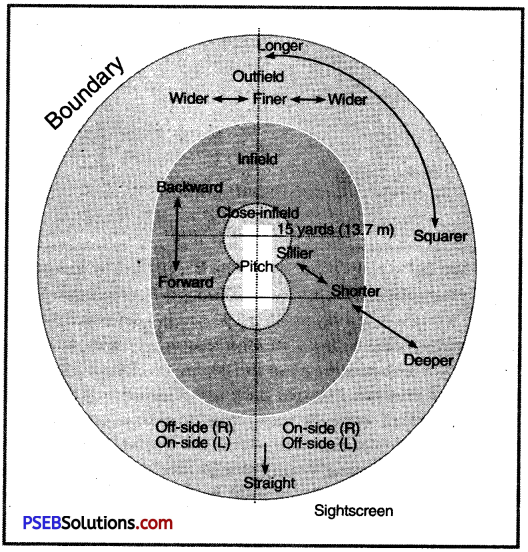
Wickets:
Three-three wickets shall be fixed in front of each other, and the distance between these fixed wickets shall be 22 yards (20.12 m). The breadth of the wickets shall be 9″. The wickets have three stumps each and there shall be two bails to be placed on them. The stumps shall be equal and shall be so planted as to prevent the ball from passing through them. The top of the stumps from ground shall be 28 “. Each bail shall be 4 3/8in length and when in position on the position of the stumps shall not project more than above them.
![]()
Bowling and Popping Creases:
The bowling creases shall be drawn 8′. 8″ straight in length, with stumps in the centre. The popping creases shall be marked 4 feet in front of and parallel to the bowling crease. It shall extend by 6′ on either side of the stumps. The return crease shall be drawn perpendicular to the two ends of the bowling crease, and it shall be extended to meet the popping crease. Both the return and popping creases are deemed unlimited in length.

Innings:
Each team has to play two times by turn. It is decided by toss as to which team shall play first. If the team playing first has scored 200 runs in 5 or more than 5 day match, 150 runs in 3 day match, 100 runs in two day match and 50 runs in 1 day match over and above the runs made by the opposing team, it can ask the other team to play again, that is, it can declare follow on. The captain of the batting team can also declare the close of innings before time.
Start and Finish and Intervals:
Everyday at the start of each innings before the start of the match the captain says “play”, and if the team refuses to play, it shall lose the match. Ten minutes in each innings and maximum 2 minutes in the coming of each new batsman are allowed. Runs are reckoned for scoring. When a batsman after hitting the ball reaches from one end to the other, one run is deemed to be completed. If a batsman turns back without reaching the other end, that is not considered as a run. This is called short run. If while making the run, the ball is in the air and is caught, no run shall be deemed to be scored. Similarly, if a batsman is run out, the run being attempted shall not be counted.
Boundary:
If the ball crosses the boundary line having touched the ground, after a batsman has hit it, it is called boundary. Four runs are given for a boundary. If the hit ball falls out of the boundary line without touching the ground, six runs are made. If the boundary results from an overthrow or is intentionally made by the fieldsman, then the scored runs and the runs of the boundary shall be counted in the score.
![]()
Lost Ball:
If the ball is lost, any fieldsman can declare it to be lost. In such a situation, the umpire can re-start the game with a new ball the condition of which resembles that of the lost one.
Results:
Any team which makes more runs in its two innings is considered winner team. In case a match is not completed, it is regarded as a draw.
Over:
In each over the ball is bowled six times. These overs are done alternatively on each wicket. “No ball” and “wide ball” are not reckoned in an over. The number of extra balls bowled in an over shall be equal to the number of “no-balls” in that over. No bowler can bowl two overs continuously in one innings. If the umpire fails to remember the number of balls in an over, the over considered by the umpire shall not be counted.
Fall of Wickets:
The wicket is known as down when the batsman himself or his bat or ball removes either bail from the top of the stumps or both bails be off or strikes a stump out of the ground.
Dead Ball:
The ball shall be deemed to be a dead ball in the following cases:
- When the ball has been properly caught by the bowler or wicket keeper.
- When the ball reaches or bounces over the boundary.
- When the ball, without being played, lodges in the dress of a batsman or a bowler.
- When a batsman is out.
- If the umpire decides to stop the game after the bowler gets back the ball.
- On the call of ‘over’ or ‘time’ by the umpire.
No Ball:
While playing the ball if the front foot of the bowler goes ahead of the batting crease or cuts the returning crease, the umpire declares No Ball. After hitting the ball the batsman can make as many runs as possible. The runs made in this way will be added to the score. If no run has been made, only one run will be added to the score. By spreading one of his arms the umpire gives the signal of no ball.
Wide Ball:
The umpire declares a wide ball if the bowler bowls the ball high over or wide over the wicket which, in the opinion of the umpire, is out of the reach of the batsman. The runs made during the wide ball are reckoned in the wide ball. If no run is attempted, it is reckoned one run. The umpire gives the signal of wide ball by spreading his both arms straight.
![]()
Bye and Leg-bye:
The umpire shall declare ‘bye’ if the properly bowled ball passes the batsman (striker) without touching his bat or body and the run is obtained. But it should not be no-ball or wide-ball. But if the ball touches any part of the striker’s body except his hands which, hold the bat and any run is got, the umpire shall declare “leg-bye.”
Out of his Ground:
A batsman shall be reckoned to be out of his ground until some part of his bat in hand or of his person is grounded behind the ground of popping crease.
Batsman’s Retirement:
A batsman owing to illness or injury may retire at any time. He may bat but he will have to seek the permission of the captain of the opposing team to know his number of batting.
Bowled:
If the wicket is bowled down, the striker (batsman) is said to be bowled out, even if the ball has touched first his body or foot.
Catch:
If the ball from the stroke of a bat or of the hand holding the bat (not the wrist) is caught by a fieldsman before it touches the ground, the batsman is “caught out”. At the time of a catch both the feet of the fieldsman should be on the ground of the playfield. If the fieldsman catches the ball out of the boundary line, the batsman is not reckoned to be out, but is awarded 6 runs. If the ball lodges in the pads of the wicket-keeper, the batsman shall be reckoned to be “caught out.”
Handle the Ball:
During play, if the batsman touches the ball with his hand, he shall be reckoned to be out-“handle the ball out.”
Hit the Ball Twice:
If the ball is struck or stopped by any part of the batsman’s body after it has been hit, and if the batsman deliberately strikes it again, he shall be out. The ball can be hit twice only to defend the wicket but the condition is that it must have been done to defend the wicket. If any run is made in this process, it is not counted.
Wicket is Down or Hit Wicket:
If during the play, the batsman hits down his wicket with any part of the bat or body, it is called “hit wicket out.” If the wicket falls down as a result of the fall of his cap or hat or any broken part of his bat, even then he shall be reckoned to be “hit wicket out.”
![]()
L.B.W. (Leg Before Wicket):
The batsman is considered to be “L.B.W. out” when he tries to obstruct the ball with any part of his body before touching the ball with his bat, and in the opinion of the umpire, the ball and the wicket are in a straight line. If the batsman had not obstructed the ball with any part of his body, the ball would have straight hit the wicket.
Obstructing the field:
If a batsman deliberately obstructs a fieldsman from catching the ball, he can be out “obstructing the field.”
Stumped:
A batsman is out if his bat in hand and his foot is not on the ground behind the supposed popping crease. The batsman is considered to be outstumped when the ball is not “no ball” and is bowled and the batsman goes out of his ground otherwise than attempting a run, and then wicket-keeper outstumps the wicket (removes the stumps placed over the wickets).
Run Out:
The batsman is run out when the ball is in play, the batsman goes out of his ground to score a run, and his wicket is put down by the opposite side. If batsmen cross each other, that batsman will be considered to be “run out” who is running to the fallen wicket.
Wicket-keeper:
The wicket-keeper shall always remain behind the wickets until a ball delivered by a bowler touches the bat or the body of the striker or passes the wicket or the batsman is “out”. He cannot catch the ball.
Fielders:
The fieldsman can stop the ball with any part of his body. He is not allowed to stop the ball with his cap. If he does so, its penalty shall be four runs. In case no run has been made, four runs shall be added.
Field Setting in The Game Of Cricket:
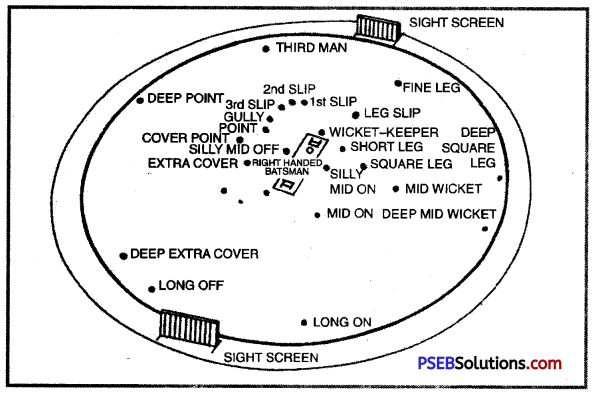
A.
- Wickets
- Bowling crease
- Return crease
- Popping crease.
B.
Position of players:
- Slips
- 3rd man
- Gully
- Point
- Cover-point
- Extra-cover
- Mid-off
- Bowler
- Straight
- Mid-on
- Long-on
- Mid-wicket
- Square leg
- Fine leg
- Leg-slips
- Short leg
- Silly mid-off
- Silly mid-on
- Silly point
- Backward point
- Wicket-keeper.
![]()
Field, Weather and Light:
Before a match starts captains of both the teams will decide about the suitability of the field, weather and light. If they have not given their consent regarding these issues, the umpire shall decide the matter.
Appeal:
The umpire shall not order any batsman out unless a fielder makes an appeal in this regard. This appeal should be made before the delivery of the next ball and before the time is over. The fielder while appealing shall ask the umpire how it happened. The umpire signals ‘out’ by raising the index finger.
Mandatory over:
On the last day of the match, one hour before the close of the match, the umpire signals about the mandatory over. After this, a game of 20 overs is played. 6 Balls are bowled in an over. If it seems the match would be a draw, the game can be ended before the completion of these overs.
Dead Ball:
Dead ball is considered only in certain situations-when the ball settles down completely in the hands of a bowler or wicket-keeper or reaches the boundary line; when it is lodged in the dress of the umpire or batsman or the umpire gives the call of ‘over’ or ‘time’, and in addition to these, when a player is out or receives a serious injury.
Obstructing the Field:
If a batsman intentionally obstructs the game of the opposing team as a result of which the opposing team is obstructed from catching the ball, then the batsman is reckoned to be out. This is called ‘obstructing the field.’
Various types of matches:
1. Test Match: In test match both teams get a chance to play two innings. A test match is played for 5 days.
2. One-day Match:
There is a one day national and international match in which both the teams play in 40-40 or 50-50 overs. The team which scores more runs becomes the winner.
3. 20-20 Match: Like one day match, it is called 20-20 over match because both teams play for 20-20 overs.
![]()
There are new rules for 20-20 match as mentioned under:
1. Free Hit:
When a bowler balls while crossing bowling crease, then it is considered as ‘No ball’. In this case bats man gets free hit and during free
hit batsman will not be out in any case except mn out.
2. Power Play:
As per new cricket rules. In 50 overs match, power play shall be 10 overs, 5 overs and 5 overs. First power play is to be taken in the beginning of the game. 5-5 overs batting & fielding power play can be taken any time.
Some Important Techniques in Cricket Expertise And Techniques in Batting:
To play a hit successfully batsman should play heed to three points to find out the ball and attend to it; to decide which hit will be appropriate; and to turn the body to play the hit in a proper manner. It seems to be very easy, but in fact, it is not so easy. It is easy to think that you are looking at the ball. In reality, it is easy to watch the coming ball provided you are mentally prepared.
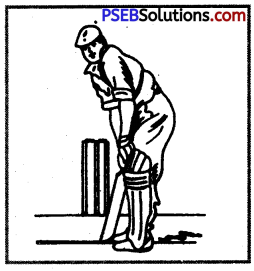
It is indeed a tough task to form the habit of judging, in the real sense of the term, of each and every ball in the entire innings. You can do it by learning to concentrate on the task in your hand. It is, indeed, difficult, but if you learn to do so, not only will it prove to be of use to you in cricket but in life as well. To take a right decision as to how to hit a particular ball is a matter of a sort of inner-inspiration which in cricket is often called “child understanding.” However, it is a matter of experience.
The position of the player:
A player’s restful, tension-free and balanced position is very essential. On it depends the right judgement of the ball and the foot movement for each stroke. Normally, the feet should remain parallel to the sides of the crease, and their toes directed towards the aim.
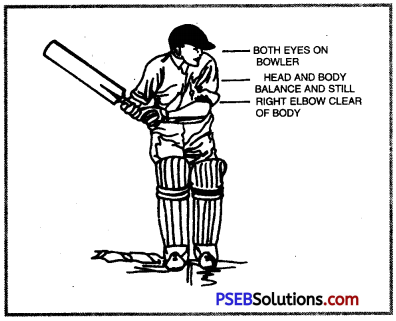
Back Lift:
A right back lift is of immense importance. The left arm and wrist should do the whole job, and as the bat rises its front side should be directed towards the aim. The head and body should remain perfectly motionless. As the bat is raised, the right elbow should be slightly separated from the body and the left hand should be upward exactly in front of the right pocket. The bat should move on the desired hit line below. It is but natural that the back lift will be firmer at the time of attack.
The Forward Stroke In Defence for The Straight Ball:
The forward stroke in defence is not only very precious but also the basis of the all hits. If one plays it well, one becomes at least half batsman. Its aim is to play the ball as much as possible from the proximity of the point. In this stroke, the bat is to touch the ball a few inches before the left foot by moving the head forward and by keeping the left buttock and shoulder out of the ball line. The feet should be towards the middle of mid-off and extra-over. The body weight should be directly with the bent left knee.
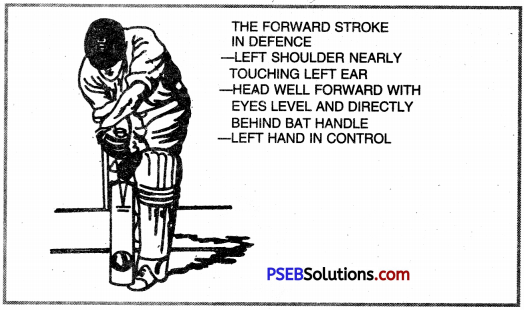
Stroke:
Judge the ball throughout its path. As far as possible, you should keep your head in balance while you do so. Don’t feel tempted much to raise your head.
Control in Hits:
The control is essential in taking hits. If you want to take a hard hit, your hit can be longer instead of turning.
In order to hit the ball easily and clearly, the ball should be thrown in the ground instead of towards the boundary line.
If the ball is quite high in the air, the hit can be taken with one long step. You should also learn to make use of your feet in playing a comparatively slow and quicker and shorter ball on the pitch.
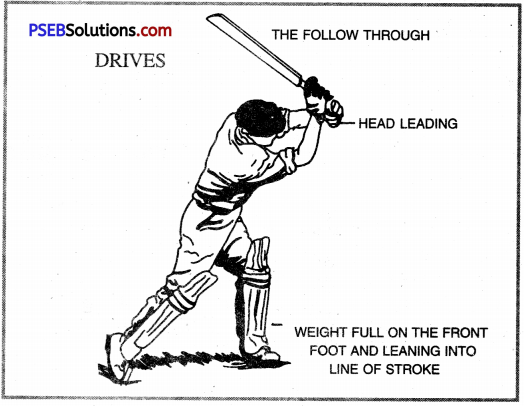
Off Drive:
In off-drive, it is essential that your head, left shoulder and waist should remain on the ball line. If they are in the right direction, the left foot automatically performs its function in the right direction. In order to receive the out-of reach ball and ordinary ball the back of the left shoulder should be towards the bowler, and the aim of the hit should be towards off-side. In fact, the bat will begin its downward movement from the line of fine leg. As far as possible, the whole of the bat should move through the hit-line.
![]()
On-drive:
Many boys lack the ability of on-drive. If they get it, they can increase their capacity or ability of taking more runs. In it, the left shoulder is kept slightly low, the left foot and the line of balance are kept in right proportion and the head is moved ahead. It will enable one to approach the line of ball. The left foot shall remain slightly away.
The batsman should take the aim of hit, and the whole wide side of the bat should move down towards the line. In his on-drives, a batsman will have to resolutely discourage the tendency of depending too much on his right hand and right shoulder for the hit. He should also have a check on his left buttock going after.
Until a batsman has a good judgement of the pitch, he should continue to play with back stroke. In this way, he will get time to judge the ball after the pitch. In case of slow ball and more difficult pitch, he must depend upon the back stroke. The right foot with toe in parallel to the crease can make good movement inside and back side of the ball line. The weight of the body can be shifted on this foot but the head must lean slightly forward. The left foot on toe acts as a good balancer.
The ball should meet immediately below the eyes, and it should be at the level as eyes watch the ball downward the pitch. The control over hit is made by raising the elbow by the left hand and arm. The right hand, in the hold of the thumb and fingers, is relaxed. As far as possible, the body should be kept side ways.
Even Bat Stroke:
A boy cannot become a batsman until he learns how to take a direct hit. He should also know how to play a wrong ball, and it can be possible and effective through cross-bat hits. It seems to be particularly true in the case of long and full bounces, and provides good opportunities of scoring 4 runs (hitting boundary) particularly in the junior cricket. These hits are more easy as they are more natural than direct bat hits. But in order to play hits effectively, you should learn to play more efficiently.
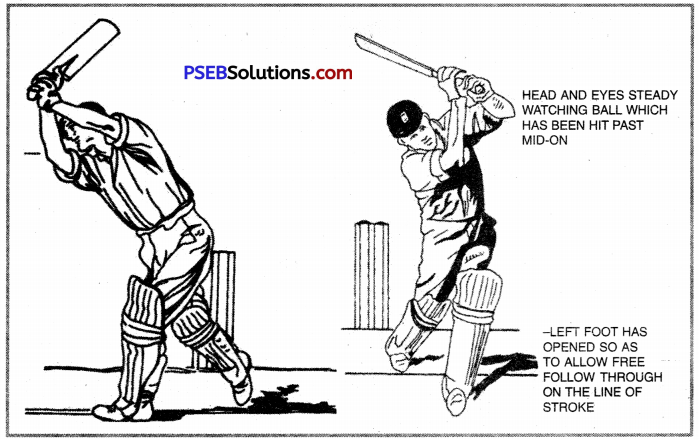
Back-Foot Square Cut:
In order to tackle the ball received from the ball line and point from the front and back sides, the right foot moves across the buttock-line. Then the wrists and hands are moved down from a high bat- lift, and the head and body move over the bent right knee in the stroke line
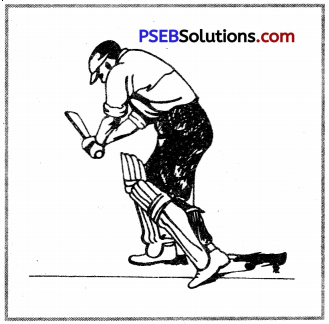
Late Cut:
This hit is similar to the above-mentioned hit except that it begins with a sharper turn of the left shoulder, and the right foot on the toe, towards third slip, is on the ground. The ball is received at the level of wickets, and the batsman hits it in the direction of the gully or second slip. In these two cuts, the left foot remains on the toe in the relaxed condition, and the weight remains fully on the bent right shoulder.
![]()
Cricket Game Important Tournaments
- I.C.C. Trophy (ODI)
- Reliance Cup
- Hero Cup
- Australia Cup (One day)
- Champions Trophy (ODI)
- Benson and Hedges CUP (ODI)
- Rothmans Cup (ODI)
- Wills Trophy
- Pepsi Cup
- Coca-Cola Trophy (Asian test)
Cricket Game Important Questions
Question 1.
Number of players in cricket team.
Answer:
11.
Question 2.
What is the width of wicket?
Answer:
9” (22.9 cm)
Question 3.
What is the weight of cricket ball?
Answer:
155.9 gm to 163 gm.
Question 4.
What is the name of first cricket club?
Answer:
Hambildon Cricket Club.
Question 5.
When did First One day match was played in India?
Answer:
5 January 1971.
Question 6.
What is the full form of LBW?
Answer:
Leg Before Wicket.
Question 7.
Name any four cricket strokes.
Answer:
On-Drive, Back Stroke, Straight Drive Late Cut.
![]()
Question 8.
How many umpires are there in cricket?
Answer:
2 Umpires on the field and 1 third umpire.
Question 9.
What is the length of cricket pitch from wicket to wicket?
Answer:
22 yards (20.12 cm).
Question 10.
When did First test match was played in cricket?
Answer:
In 1877 (Australia & England).
Question 11.
Under whose captainship 1983 World Cup was won by India.
Answer:
Kapil Dev.
Question 12.
When the twelth man gets substitution in cricket?
Answer:
When any player gets injury on the field.
Question 13.
How many types of matches are played in cricket?
Answer:
One-day match, test match, 20-20 match.
Question 14.
What is the length of Bowling crease?
Answer:
8’8” (2.64 m).
![]()
Question 15.
What is the area of small circle?
Answer:
27.4 m.
Question 16.
What is the height of wicket from ground?
Answer:
28” (71 cm).
Punjab State Board PSEB 12th Class Physical Education Book Solutions 12th Class Physical Education Practical Cricket Important Notes, Questions and Answers.
